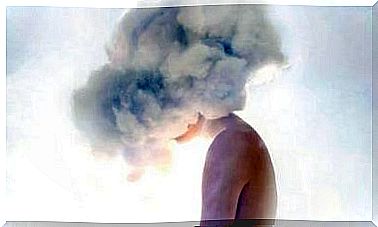The Link Between Family Dynamics And Eating Disorders

Eating disorders are disturbances or changes in behavior related to food and thus to food intake. However, very few studies exist on the association between family dynamics and eating disorders.
However, there are also some studies that take their relatives into account. The purpose of this article is to introduce you to the Expressed Emotion model in relatives of people with eating disorders. We will also talk about the influence of family dynamics on the development of this psychopathological disorder.
Eating disorders are maintained for extended periods of time. They imply a decline in a person’s physical health. In addition, there is a decline in their psychological, social and family dynamics.
These disorders are widely researched. This has to do with their predominance among the female population. Estimates reveal that up to 4% of teens and female young adults in the western world are currently affected. However, there are very few studies on the family dynamics of people with eating disorders.
This is an unavoidable and urgent challenge. After all, the percentage of teenagers at risk of developing an eating disorder is huge. This is a social problem.
We can connect it directly to family dynamics. It has many consequences for their general well-being. In addition, it is also extremely relevant because the family members have a significant influence in the course of this disorder.
What leads to eating disorders?

Numerous studies attempt to identify not only the triggers of eating disorders. They also want to find the pervasive factors.
Models such as the multifactor model of Vohs, Bardone, Joiner, Abrahamson and Heatherton (1999) emerged. They showed the role of perfectionism in the development of the symptoms of anorexia nervosa.
The National Autonomous University in Mexico, among others, conducted a more recent study. They describe this perfectionism as an exaggerated concern about being wrong or making mistakes. They also compare this to indecision.
They also emphasize things like body dissatisfaction and negative self-image. This then goes along with starting a strict diet and weight gain.
There are also other risk factors such as family conflict or critical issues related to weight and body shape. These can also play a role when an eating disorder develops.
As for the pervasive factors of this condition, dietary restrictions, laxative behavior, and a very diminished social environment are the most common. It is in this last factor that the attitudes of their immediate family are reflected.
Family dynamics and eating disorders: the role of expressed emotion (EE)
Expressed emotion is the emotional communication style within the family. It is also one of the pervasive factors in eating disorders. EE is a model that began to take shape in the 1950s at the Institute of Psychiatry, Psychology and Neuroscience in London.
In a first study, the researchers established the following. In people with schizophrenia, most relapses occurred in those who were returned to their old family dynamics.
As a result, they then conducted studies to explain the elements of the family nucleus. They believed it had something to do with the relapse of those people who had returned to their homes.
Brown, Birley, and Wind actually discovered three features that are absolutely linked to the development and pervasive nature of the condition:
- Hostility
- Emotionally over-involved
- Criticism
Other authors such as Muela and Godoy also add warmth and positive comments. In the family members of people with eating disorders, the EE model presents characteristics similar to those found in the previous study of schizophrenia.
Elements of Expressed Emotion
- Criticism. A family member’s negative evaluation of the behavior of a person with an eating disorder. (Not only does the content reflect the criticism but also the way they said it.)
- Hostility. Rejection by a family member. It’s not just criticizing something the person with an eating disorder did. This is also a general attack on them as individuals.
- Emotional Exaggerated Involvement. Intense emotional reactions from the family members in an effort to control the behavior of a person with an eating disorder.
On the one hand, the emotional response can be constant sobbing and crying due to the situation. On the other hand, there is the self-sacrifice that this condition requires. In addition, there is also talk of overprotection. - Warmth. Appropriate emotional response from the family members characterized by empathy, affection, and interest.
- Positive Comment. Verbal notes of affection addressed to the person with an eating disorder.
Expressed emotion: the link between family dynamics and eating disorders
All of these elements seem to play an essential role in the course of a person with an eating disorder. For example, there may be high levels of critical commentary, hostility, and emotional over-involvement.
Then the family context of the person with problems becomes compelling. The context then becomes much more protective and less flexible.
Longitudinal studies in the field show that there are differences between eating disorder cases. They lasted less time compared to the cases that became chronic. Researchers found that only 6% of the family members of those individuals who recovered quickly showed high levels of expressed emotion.
Numerous authors have also examined the association between EE in family members and the development of the eating disorder. This is in contrast to just studying its pervasive nature when they had the disorder. The results showed that between 55 and 60% of family members of people with eating disorders had high EE.
The importance of family dynamics in the development of eating disorders

Taking into account what we have just discussed, it is necessary to make psychological education part of the treatment. If necessary, the intervention of the family of the person with an eating disorder may also be required in the psychological treatment.
Good family emotional adjustment is vital for improvement in people with eating disorders. All family members can then control their emotions. They can have a way out of their emotions at the right time.
In addition, it is crucial to involve the family members. This is especially true when most individuals affected by eating disorders are young.
No one expects family members to know exactly what to do and how to handle it. This is why they should be part of the full treatment. After all, they are a huge part of the healing.
So it’s important not to blame family members. We need to teach them to stop labeling those with an eating disorder.
In addition, we must learn to reinforce alternative behaviors and improvements. Or we need to learn to take a deep breath and be patient as we face a condition that can last a long time.








